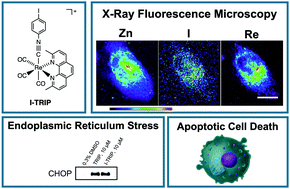X-Ray fluorescence microscopy reveals that rhenium(i) tricarbonyl isonitrile complexes remain intact in vitro†
Abstract
The complex fac-[Re(CO)3(dmphen)(para-tolylisonitrile)]+ (TRIP), where dmphen = 2,9-dimethyl-1,10-phenanthroline, is an endoplasmic reticulum stress-inducing anticancer agent (A. P. King, S. C. Marker, R. V. Swanda, J. J. Woods, S.-B. Qian and J. J. Wilson, Chem. – Eur. J., 2019, 25, 9206–9210). A second-generation compound fac-[Re(CO)3(dmphen)(para-iodobenzeneisonitrile)]+ (I-TRIP) was synthesized, and its intracellular distribution was investigated using X-ray fluorescence microscopy to show that these complexes are highly stable in vitro.

- This article is part of the themed collection: Chemical Communications HOT Articles


 Please wait while we load your content...
Please wait while we load your content...